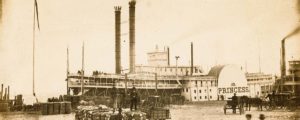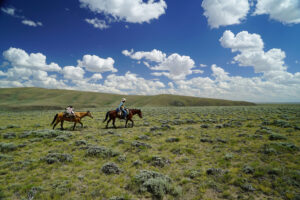Andy Warhol created a West portfolio a year before his death.
Andy Warhol may be better known for his cans of Campbell’s Soup and his Marilyn Monroes, but his penchant for making Pop Art out of America’s national myths also drew him to the Wild West. One year before his death in 1987, Warhol produced Cowboys and Indians, a portfolio of 10 screen prints that includes George Custer, Annie Oakley, Teddy Roosevelt, John Wayne and Geronimo, as well as native American artifacts such as Hopi Kachina dolls, a Plains Indian shield and a Tlingit Northwest Coast mask.
True to his career-long interest in blurring the line between high art and commerical manufacture, Warhol and his team of studio assistants produced each image in 36 different trial proofs of varying colors and tones. Warhol then selected his favorite to produce in a print run of 250 copies. Four images, including Sitting Bull and an action still from a Western movie, did not make the official print run.
Warhol selected iconic Western black-and-white photographs for his portfolio: an 1864 Mathew Brady shot of Brevet Maj. Gen. George Armstrong Custer sitting with arms crossed; an 1884 A. Frank Randall photo of a defiant and yet-unconquered Geronimo; and a publicity shot of sharpshooter Annie Oakley from Buffalo Bill’s German tour. He photographed the Indian artifacts himself at the Gustav Hay Museum of the American Indian in New York City, promising the museum the original silkscreen prints in return.
Warhol produced his prints through a patented silkscreen process, tracing the photographs onto a porous screen and then quickly imprinting the screen onto canvas and applying paint over it. The bright, assembly line colors and blotted lines that highlight Custer’s long yellow hair and red handkerchief seem like a natural fit for a man who was, after all, no stranger to manipulating his own image in the popular imagination. Annie Oakley—known as “America’s Sweetheart”—is another highlight of the portfolio.
Although the New York artist may seem a world away from the rugged West, Matt Wrbican, archivist at the Andy Warhol Museum in Pittsburgh, Pa., points out that Warhol had a keen interest in Western motifs. “Warhol had a fantastic collection of native American art and artifacts, such as blankets, silver, beaded objects and pottery, as well as dozens of Edward S. Curtis’ photographs of native Americans,” says Wrbican. “He even owned several Western-genre children’s books from the Big Little Books series, which he started collecting in the 1970s.
“He also had an interest in Buffalo Bill Cody, the tracker-turned-showman who is often credited with inventing the notion of someone ‘famous for being famous,’ which appealed to Warhol.” Wrbican also noted that the artist shot the movie Lonesome Cowboys in Tucson, Ariz., in 1967, spent time later in life on his undeveloped ranchland near Aspen, Colo., and had a registered cattle brand (the “A lazy-W”).
Warhol’s affinity for the West did not, however, mean that the production of Cowboys and Indians went smoothly. The artist accidentally—and for the first time in his career— entered into a contract that granted creative control to the publishers, which resulted in constant tampering on their part. Warhol at one point complainined in his diary: “[The publisher] is there saying, ‘I don’t like [John Wayne’s] color. What color will the lips be?’ And, I mean, it’s a blue face. What difference does the color of the lips make, when it’s a blue face. I mean, he’s ridiculous.” Also during the production run, John Wayne’s son Patrick sued over the right to reproduce a John Wayne movie still. The lawsuit was still ongoing at the time of Warol’s death after gallbladder surgery in February 1987.
Warhol’s untimely death obscured Cowboys and Indians, but the portfolio has several features that make it unique among his screen prints, including uniform white backgrounds and a large amount of hand drawing. The prints have received a well-deserved reappraisal at traveling exhibits, including the retrospective “Pop Goes the West” at the Eiteljorg Museum of American Indians and Western Art in Indianapolis last year. Two of the prints will be included in a show at the Memphis Brooks Museum of Art in Tennessee from June to September 2008.
Originally published in the June 2008 issue of Wild West. To subscribe, click here.




